Potřebujeme váš souhlas k využití jednotlivých dat, aby se vám mimo jiné mohly ukazovat informace týkající se vašich zájmů. Souhlas udělíte kliknutím na tlačítko „OK“.
ASTM E1207-14
Standard Guide for Sensory Evaluation of Axillary Deodorancy
Automaticky přeložený název:
Standardní Průvodce pro senzorické hodnocení podpažní Deodorancy
NORMA vydána dne 1.3.2014
Informace o normě:
Označení normy: ASTM E1207-14
Poznámka: NEPLATNÁ
Datum vydání normy: 1.3.2014
Kód zboží: NS-40858
Počet stran: 17
Přibližná hmotnost: 51 g (0.11 liber)
Země: Americká technická norma
Kategorie: Technické normy ASTM
Kategorie - podobné normy:
Anotace textu normy ASTM E1207-14 :
Keywords:
ICS Number Code 71.100.70 (Cosmetics. Toiletries)
Doplňující informace
| Significance and Use | ||||||
|
5.1 The procedures recommended in this practice can be used to clinically assess axillary deodorant efficacy of personal care products. 5.2 This practice is applicable to the product categories which include deodorant and toilet soap bars, liquid bath soaps and gels, deodorant sticks, antiperspirants, creams and lotions, body talcs, and aerosol and pump delivery deodorants, antiperspirants, and body colognes. 5.3 Procedures of the type described herein may be used to aid in the communication of efficacy within and between manufacturers and to the consumer through the various public communications media. Guidelines are suggested due to the need to determine the relative or absolute performance of experimental materials or of commercial products. 5.4 These procedures may be used by persons who have familiarized themselves with these procedures and have had previous experience with sensory evaluation. 5.5 This practice provides suggested procedures and is not meant to exclude alternate procedures which may be effectively used to provide the same clinical result. |
||||||
| 1. Scope | ||||||
|
1.1 This guide provides procedures which may be used in the design and analysis of studies to quantitatively assess the intensity of human axillary odor for the purpose of substantiating deodorant efficacy of personal care products. 1.2 This guide includes protocols for the selection and training of assessors, selection of subjects, experimental design, and statistical analyses. This practice is limited to assessment of axillary odor by trained assessors. Self-evaluation protocols are valid for selected sensory tasks but may be less sensitive. 1.3 With respect to the source of axillary odor, three groups of secretory glands are present in the axillae which participate to a greater or lesser extent in its production—eccrine, apocrine, and sebaceous. Axillary odor has been primarily ascribed to the apocrine gland secretion (1) .2 Body odor intensity has been correlated with the volume of the secretory portion of the apocrine gland (2) and the density of the glands. 1.3.1 Apocrine glands are found primarily in the axillary vault in conjunction with axillary hairs 1.3.2 Eccrine glands keep the axillae moist through thermally and emotionally induced secretions 1.3.3 The sebaceous glands excrete higher molecular weight lipid materials which absorb and retain the volatile materials resulting from bacterial action (7) . The aerobic diphtheroids are able to produce the typical acrid axillary odor and the micrococcaceae produce an isovaleric acid-like odor when incubated with apocrine sweat 1.4 Personal care products are sold and used primarily for their ability to reduce the perception of body odor not only by the individual using the product but also by individuals within the scope of contact. Deodorant protection may be achieved by these products through various modes of action. Antiperspirants achieve their primary efficacy by means of the action of inorganic salts on the eccrine gland production of sweat. Antimicrobial agents achieve deodorancy by inhibiting the growth and activity of the microflora in the axillary vault thus reducing the microbial decomposition of sweat and the consequent production of body odor. Absorbents function either by “binding” available moisture or malodorous substances. Fragrances are effective by altering the perception of malodor and increasing the degree of “pleasantness.” Other modes of control become important from time to time, representing changes in the state-of-the-art in product development. 1.5 The studies discussed herein are interpreted through the use of statistical tests of hypotheses. These hypotheses are usually of the form:
1.5.1 It should be noted that
failure to reject this hypothesis at a specified level of
significance does not prove the hypothesis, but merely that the
weight of evidence provided by the experiment is not sufficient to
reject the hypothesis. This could occur because either:
Standard Test Method for Unipolar
Magnitude Estimation of Sensory Attributes Standard Terminology Relating to Sensory
Evaluation of Materials and Products (Includes all amendments and
changes 8/21/2023). |
Podobné normy:
Historická
1.9.2011
Historická
1.5.2013
Historická
15.10.2012
Historická
15.10.2012
Historická
1.4.2010
Historická
1.4.2014
Doporučujeme:
Aktualizace technických norem
Chcete mít jistotu, že používáte pouze platné technické normy?
Nabízíme Vám řešení, které Vám zajistí měsíční přehled o aktuálnosti norem, které používáte.
Chcete vědět více informací? Podívejte se na tuto stránku.


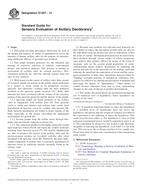
 ASTM E1490-11
ASTM E1490-11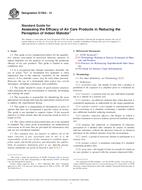 ASTM E1593-13
ASTM E1593-13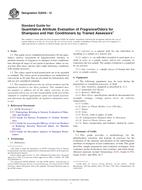 ASTM E2049-12
ASTM E2049-12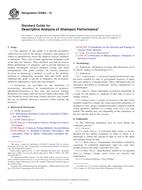 ASTM E2082-12
ASTM E2082-12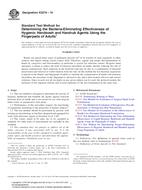 ASTM E2276-10
ASTM E2276-10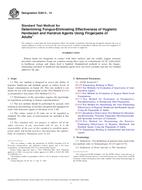 ASTM E2613-14
ASTM E2613-14
 Cookies
Cookies
